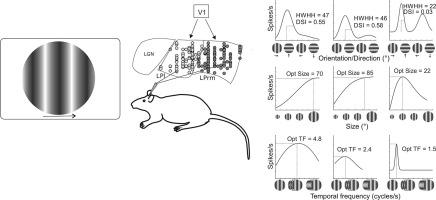Neuroscience ( IF 3.3 ) Pub Date : 2020-06-27 , DOI: 10.1016/j.neuroscience.2020.06.030 Andrzej T Foik 1 , Leo R Scholl 2 , Georgina A Lean 2 , David C Lyon 1

|
The pulvinar is a higher-order thalamic relay and a central component of the extrageniculate visual pathway, with input from the superior colliculus and visual cortex and output to all of visual cortex. Rodent pulvinar, more commonly called the lateral posterior nucleus (LP), consists of three highly-conserved subdivisions, and offers the advantage of simplicity in its study compared to more subdivided primate pulvinar. Little is known about receptive field properties of LP, let alone whether functional differences exist between different LP subdivisions, making it difficult to understand what visual information is relayed and what kinds of computations the pulvinar might support. Here, we characterized single-cell response properties in two V1 recipient subdivisions of rat pulvinar, the rostromedial (LPrm) and lateral (LPl), and found that a fourth of the cells were selective for orientation, compared to half in V1, and that LP tuning widths were significantly broader. Response latencies were also significantly longer and preferred size more than three times larger on average than in V1; the latter suggesting pulvinar as a source of spatial context to V1. Between subdivisons, LPl cells preferred higher temporal frequencies, whereas LPrm showed a greater degree of direction selectivity and pattern motion detection. Taken together with known differences in connectivity patterns, these results suggest two separate visual feature processing channels in the pulvinar, one in LPl related to higher speed processing which likely derives from superior colliculus input, and the other in LPrm for motion processing derived through input from visual cortex.
Significance Statement
The pulvinar has a perplexing role in visual cognition as no clear link has been found between the functional properties of its neurons and behavioral deficits that arise when it is damaged. The pulvinar, called the lateral posterior nucleus (LP) in rats, is a higher order thalamic relay with input from the superior colliculus and visual cortex and output to all of visual cortex. By characterizing single-cell response properties in anatomically distinct subdivisions we found two separate visual feature processing channels in the pulvinar, one in lateral LP related to higher speed processing which likely derives from superior colliculus input, and the other in rostromedial LP for motion processing derived through input from visual cortex.
中文翻译:

大鼠 Pulvinar 外侧和内侧细分的视觉反应特征。
丘脑是丘脑的高阶中继,是膝外视觉通路的中心组成部分,输入来自上丘和视觉皮层,输出到所有视觉皮层。Rodent pulvinar,通常称为外侧后核 (LP),由三个高度保守的细分组成,与更细分的灵长类 pulvinar 相比,其研究具有简单性的优势。对 LP 的感受野特性知之甚少,更不用说不同 LP 细分之间是否存在功能差异,这使得很难理解中继哪些视觉信息以及 pulvinar 可能支持哪些类型的计算。在这里,我们在大鼠 pulvinar 的两个 V1 受体细分中表征了单细胞反应特性,rostromedial (LPrm) 和外侧 (LPl),并发现四分之一的细胞具有定向选择性,而 V1 中只有一半,并且 LP 调谐宽度明显更宽。响应延迟也明显更长,首选大小平均比 V1 大三倍以上;后者表明 pulvinar 作为 V1 的空间背景来源。在细分之间,LP1 细胞更喜欢更高的时间频率,而 LPrm 显示出更大程度的方向选择性和模式运动检测。结合已知的连通性模式差异,这些结果表明在 pulvinar 中有两个独立的视觉特征处理通道,一个在 LPl 中与可能来自上丘输入的更高速处理有关,另一个在 LPrm 中用于通过输入从视觉皮层。
意义声明
pulvinar 在视觉认知中具有令人困惑的作用,因为在其神经元的功能特性与其受损时出现的行为缺陷之间没有发现明确的联系。丘脑,在大鼠中称为外侧后核(LP),是一种高阶丘脑中继,其输入来自上丘和视觉皮层,输出到所有视觉皮层。通过在解剖学上不同的细分中表征单细胞响应特性,我们在 pulvinar 中发现了两个独立的视觉特征处理通道,一个在横向 LP 中与可能来自上丘输入的高速处理相关,另一个在 rostromedial LP 中用于运动处理衍生通过视觉皮层的输入。



























 京公网安备 11010802027423号
京公网安备 11010802027423号